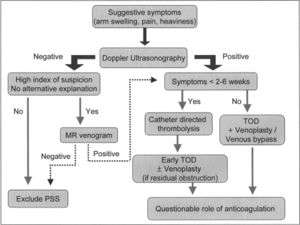Paget-Schroetter syndrome
Background
- Thrombosis of the axillary and/or subclavian vein associated with repetitive movements of the upper extremity, such as those with sporting events (e.g. swimming, wrestling, etc)[1]
- Usually affects dominant arm
- May be acute, subacute or chronic
Clinical Features
Differential Diagnosis
Upper extremity swelling
- Cellulitis
- Deep venous thrombosis
- Lymphatic obstruction
- Necrotizing fasciitis
- Superficial thrombophlebitis
- SVC Syndrome
- Thoracic outlet obstruction/Pancoast tumor
Evaluation
- Doppler ultrasound is preferred test
- CTV or MRV have higher sensitivity/specificity if continued clinical concern
- May also consider:
- CXR to evaluate for causes of thoracic outlet obstruction
- Laboratory testing
Management

Paget-Schroetter syndrome treatment
- Catheter-directed thrombolysis is first-line treatment for acute disease (<2-6 weeks duration)[1]
- Consider surgical thoracic outlet decompression (TOD) for chronic disease or failure of catheter-directed thrombolysis
- Anticoagulation alone is not recommended due to high rates of morbidity
Disposition
- Admit
See Also
References
- Alla, V. M., Natarajan, N., Kaushik, M., Warrier, R., & Nair, C. K. (2010). Paget-Schroetter Syndrome: Review of Pathogenesis and Treatment of Effort Thrombosis. Western Journal of Emergency Medicine, 11(4), 358–362.
This article is issued from
Wikem.
The text is licensed under Creative
Commons - Attribution - Sharealike.
Additional terms may apply for the media files.